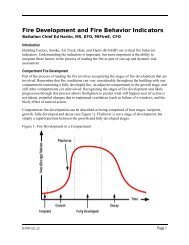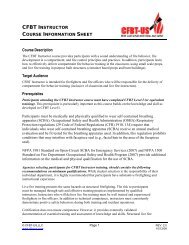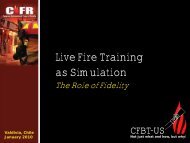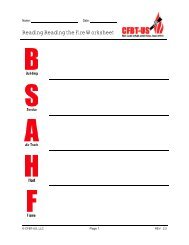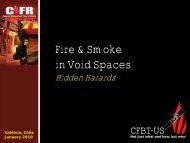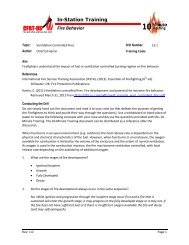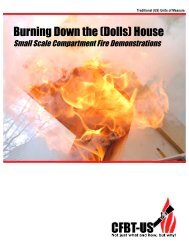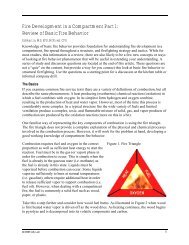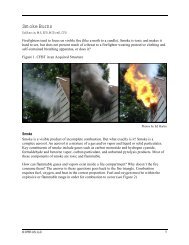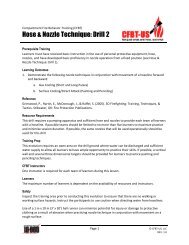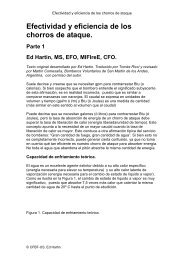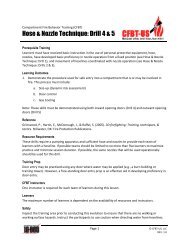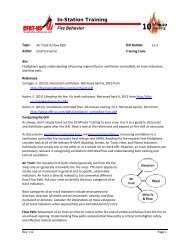CFBT Blog Post Index - CFBT-US!
CFBT Blog Post Index - CFBT-US!
CFBT Blog Post Index - CFBT-US!
You also want an ePaper? Increase the reach of your titles
YUMPU automatically turns print PDFs into web optimized ePapers that Google loves.
<strong>CFBT</strong> <strong>Blog</strong> <strong>Post</strong> <strong>Index</strong><br />
Date Title/Link Narrative<br />
080830 An Ongoing Conversation Opening post for the <strong>CFBT</strong> <strong>Blog</strong><br />
080831 Online Ventilation and Fire Behavior<br />
Course<br />
http://cfbt-us.com/wordpress/?p=4<br />
080922 Loudoun County VA Flashover<br />
http://cfbt-us.com/wordpress/?p=5<br />
080925 Loudoun County VA Flashover: What<br />
Happened<br />
http://cfbt-us.com/wordpress/?p=6<br />
080928 Loudoun County VA Flashover: Escape<br />
From Floor 2<br />
http://cfbt-us.com/wordpress/?p=9<br />
081002 Flashover and Firefighter Survival Skills<br />
http://cfbt-us.com/wordpress/?p=13<br />
081005 Positive Pressure Ventilation: Theory and<br />
Practice<br />
http://cfbt-us.com/wordpress/?p=14<br />
081009 Hazard of Ventilation Controlled Fires<br />
http://cfbt-us.com/wordpress/?p=16<br />
081013 Near Misses, Injuries, and Fatalities, Just<br />
Part of the Job?<br />
http://cfbt-us.com/wordpress/?p=17<br />
081016 That was close!<br />
http://cfbt-us.com/wordpress/?p=19<br />
081020 Entrapment Investigation & Lessons<br />
Learned<br />
http://cfbt-us.com/wordpress/?p=20<br />
Review of an online course by CFITrainer.net. This course<br />
examines the relationship between ventilation and fire<br />
behavior. While designed and developed for fire<br />
investigators, the course provides excellent information for<br />
firefighters, fire officers, and fire behavior instructors.<br />
First in a series of posts examining a serious injury incident<br />
involving flashover during an residential fire in Loudoun<br />
County VA. This post examines initial information aobut the<br />
incident and sets the stage for examination of fire behavior<br />
and tactical operations.<br />
Second post examining a serious injury incident involving<br />
flashover during an residential fire in Loudoun County VA.<br />
This post examines initial incident operations and fire<br />
behavior up until the time at which flashover occurred.<br />
Third post examining a a serious injury incident involving<br />
flashover during an residential fire in Loudoun County VA.<br />
This post details actions taken by the crews of the first<br />
arriving companies immediately after the flashover that<br />
trapped them on the second floor.<br />
Fourth post examining a a serious injury incident involving<br />
flashover during an residential fire in Loudoun County VA.<br />
This post provides a critique of recommendations related to<br />
flashover and survival skills training following this incident.<br />
Review of NIST Goes Back to School by Steve Kerber<br />
published in the September/October 2008 issue of NFPA<br />
Journal.<br />
Review of Grading the Fireground on a Curve, by Mark<br />
Emery published in the September 2008 issue of Firehouse<br />
magazine.<br />
This post examines the trend in near misses, injuries, and<br />
fatalities due to traumatic cause while operating at<br />
structure fires.<br />
This post examines a backdraft resulting in minor injuries<br />
during live fire training, the importance of near-miss<br />
reporting, and the National Near Miss Reporting System.<br />
Examination of the <strong>US</strong> Forest Service process for<br />
investigating wildland fire entrapment incidents and<br />
potential benefits to of a similar process for extreme fire<br />
behavior events in structure fires.<br />
1
<strong>CFBT</strong> <strong>Blog</strong> <strong>Post</strong> <strong>Index</strong><br />
Date Title/Link Narrative<br />
081023 Peer Review and Lessons Learned<br />
http://cfbt-us.com/wordpress/?p=21<br />
081027 Lessons Learned: The Way Forward<br />
http://cfbt-us.com/wordpress/?p=22<br />
081030 Ventilation Tactics: Understanding and<br />
Application<br />
http://cfbt-us.com/wordpress/?p=23<br />
081103 Smoke Explosion or Backdraft?<br />
http://cfbt-us.com/wordpress/?p=24<br />
081106 It’s the GPM<br />
http://cfbt-us.com/wordpress/?p=26<br />
081110 Fire Ventilation<br />
http://cfbt-us.com/wordpress/?p=30<br />
081113 NIOSH Firefighter Fatality Investigation<br />
and Prevention Program<br />
http://cfbt-us.com/wordpress/?p=31<br />
081117 NIOSH Firefighter Fatality Investigation<br />
and Prevention Program: Part 2<br />
http://cfbt-us.com/wordpress/?p=35<br />
081120 NIOSH Public Stakeholders Meeting: 19<br />
November 2008, Chicago, IL<br />
http://cfbt-us.com/wordpress/?p=37<br />
081124 Reading the Fire: B-SAHF<br />
http://cfbt-us.com/wordpress/?p=38<br />
This post discusses the <strong>US</strong> Forest Service peer review<br />
process and development of lessons learned from accidents<br />
and near miss incidents.<br />
This post emphasizes the importance of quantitative and<br />
qualitative analysis of near miss, injury, and fatality<br />
incidents and proposes a comprehensive approach to<br />
investigation and analysis.<br />
This post reviews and critiques Kriss Garcia’s article<br />
Education vs. Training in Fire Space Control (Fire<br />
Engineering, September 2008.<br />
Brief discussion of smoke explosion and backdraft as<br />
extreme fire behavior phenomena and a video clip of a<br />
transient extreme fire behavior event.<br />
Review and critique of Bob Shovald’s article Improving<br />
Preconnect Function and Operation published in the<br />
October 2009 issue of Fire Engineering magazine. This post<br />
also introduces the concept of tactical flow rate and factors<br />
influencing effectiveness of fire streams.<br />
This post reviews the text Fire Ventilation by Fire Protection<br />
Engineer Dr. Stefan Svenson of the Swedish Civil<br />
Contingencies Agency (formerly Räddnings Verket).<br />
This post is the first of a series critiquing the NIOSH<br />
Firefighter Fatality Investigation and Prevention Program.<br />
Commentary is framed in the context of a review of NIOSH<br />
Death in the Line of Duty Report F2007-29.<br />
This post continues examination of NIOSH Death in the Line<br />
of Duty Report F2007-29 and makes specific<br />
recommendation for improvement of the NIOSH Firefighter<br />
Fatality Investigation and Prevention Program.<br />
Review of the public stakeholder meeting and progress<br />
made on improvements to the the NIOSH Firefighter<br />
Fatality Investigation and Prevention Program.<br />
This post introduces the B-SAHF organizing scheme for fire<br />
behavior indicators (FBI). In addition, it provides the first in<br />
an ongoing series of video (or photo) based exercises to<br />
develop skill in reading the fire. The video is of an A-Fire in<br />
New York City.<br />
2
<strong>CFBT</strong> <strong>Blog</strong> <strong>Post</strong> <strong>Index</strong><br />
Date Title/Link Narrative<br />
081127 Choose Your Weapon: Part 1 Fire Stream<br />
Effectiveness & Efficiency<br />
http://cfbt-us.com/wordpress/?p=40<br />
081201 Choose Your Weapon: Part 2 Fire Stream<br />
Effectiveness & Efficiency<br />
http://cfbt-us.com/wordpress/?p=45<br />
081204 Criticism Versus Critical Thinking<br />
http://cfbt-us.com/wordpress/?p=55<br />
081208 Situational Awareness is Critical<br />
http://cfbt-us.com/wordpress/?p=50<br />
081211 Outstanding Performance<br />
http://cfbt-us.com/wordpress/?p=56<br />
081215 Reading the Fire 2<br />
http://cfbt-us.com/wordpress/?p=57<br />
081218 Developing & Using Case Studies:<br />
Pennsylvania Duplex Fire LODD<br />
http://cfbt-us.com/wordpress/?p=58<br />
081222 Pennsylvania Duplex Fire LODD:<br />
Firefighting & Firefighter Rescue<br />
Operations<br />
http://cfbt-us.com/wordpress/?p=63<br />
081225 Pennsylvania Duplex Fire LODD: Analysis<br />
of Contributing Factors<br />
http://cfbt-us.com/wordpress/?p=64<br />
Review and critique of FF Armand Guzzi’s article titled<br />
Analysis of Effective Fire Streams-Part I published on<br />
Firehouse.com. The post examines the influence of nozzle<br />
pressure on stream quality (droplet size in particular) and<br />
how the concepts of effectiveness and efficiency apply to<br />
water application for firefighting.<br />
This post continues the discussion of fire stream<br />
effectiveness and efficiency with a discussion of the<br />
characteristics of different types of combination nozzles.<br />
Discussion of the difference between being critical of what<br />
we see in a video clip or photo of fireground operations and<br />
thinking (and discussing) these events from a critical<br />
perspective. This post also examines Vent, Enter, & Search<br />
(VES) from the perspective of dynamic risk assessment.<br />
Examination of a flashover in a small single family dwelling<br />
experienced by the Riverdale Volunteer Fire Department in<br />
Prince Georges County Maryland based on a series of four<br />
photos.<br />
This post examines the relationship between deliberate<br />
practice and expertise. Going to fires is not enough,<br />
firefighters and fire officers require deliberate practice and<br />
the accompanying feedback to attain superior performance.<br />
The second in an ongoing series of video (or photo) based<br />
exercises to develop skill in reading the fire. Tied to<br />
application of the B-SAHF organizing scheme for Fire<br />
Behavior Indicators (FBI). Video of a C-Fire showing<br />
developing conditions on Sides C and A.<br />
This post discusses the use of case studies as an element of<br />
deliberate practice and is the first in a series of posts based<br />
on a line of duty death (LODD) in a duplex fire in Grove City,<br />
PA. This case is based on NIOSH Report F2008-06.<br />
The second is a series of posts examining a line of duty<br />
death (LODD) in a duplex fire in Grove City, PA; this post<br />
examines firefighting and firefighter rescue operations<br />
conducted during this incident. This case is based on NIOSH<br />
Report F2008-06.<br />
This post examines the factors contributing to a line of duty<br />
death (LODD) in a duplex fire in Grove City, PA. This includes<br />
discussion of the factors identified in NIOSH Report F2008-<br />
06 as well as other factors not identified by NIOSH.<br />
3
<strong>CFBT</strong> <strong>Blog</strong> <strong>Post</strong> <strong>Index</strong><br />
Date Title/Link Narrative<br />
081229 Pennsylvania Duplex Fire LODD: Analysis<br />
of NIOSH Recommendations<br />
http://cfbt-us.com/wordpress/?p=65<br />
090101 Looking Forward to 2009: 10,000 Hours to<br />
Master Your Craft<br />
http://cfbt-us.com/wordpress/?p=71<br />
090105 Estimating Required Fire Flow: The<br />
National Fire Academy Formula<br />
http://cfbt-us.com/wordpress/?p=74<br />
090108 Estimating Required Fire Flow: The Iowa<br />
Formula<br />
http://cfbt-us.com/wordpress/?p=75<br />
090112 Reading the Fire 3<br />
http://cfbt-us.com/wordpress/?p=79<br />
090115 Residential Fire Backdraft: Kernersville,<br />
North Carolina<br />
http://cfbt-us.com/wordpress/?p=81<br />
090119 Fuel & Ventilation<br />
http://cfbt-us.com/wordpress/?p=82<br />
090122 Fire Extinguishment a Historical<br />
Perspective<br />
http://cfbt-us.com/wordpress/?p=86<br />
This is the fourth post related to a line of duty death (LODD)<br />
that occurred in a duplex fire in Grove City, PA. This post<br />
examines and critiques the recommendations made in<br />
NIOSH Report F2008-06.<br />
This post examines the line of duty deaths (LODD) in 2008<br />
that resulted from extreme fire behavior and offers six<br />
resolutions to improve firefighters and fire officer fire<br />
behavior expertise through deliberate practice.<br />
Detailed examination of the origin, application, and<br />
limitations of the National Fire Academy (NFA) fire flow<br />
formula.<br />
Examination of the origin, application, and limitations of the<br />
Iowa (Royer/Nelson) fire flow formula.<br />
The third in an ongoing series of video (or photo) based<br />
exercises to develop skill in reading the fire. Tied to<br />
application of the B-SAHF organizing scheme for Fire<br />
Behavior Indicators (FBI). Video of a R-Fire in Toronto,<br />
Canada as firefighters are surprised by rapid fire<br />
development after entering Floor 2.<br />
Examination of an explosion that occurred during an R-Fire<br />
in Kernersville, NC. Investigators speculated that the<br />
explosion resulted from a backdraft in a void space beneath<br />
the house.<br />
Exploration of heat of combustion, heat release rate, and<br />
the relationship between oxygen and combustion<br />
(Thornton’s Rule). These scientific concepts are tied to the<br />
hazards presented by ventilation controlled fires.<br />
This post presents a letter to the editor that appeared in the<br />
1877 Scientific American magazine. The author of the letter<br />
advocated for the use of water spray for fire extinguishment<br />
(rather than more common solid stream nozzles).<br />
4
<strong>CFBT</strong> <strong>Blog</strong> <strong>Post</strong> <strong>Index</strong><br />
Date Title/Link Narrative<br />
090126 Myth of the Self Vented Fire<br />
http://cfbt-us.com/wordpress/?p=94<br />
090129 Water and Other Extinguishing Agents<br />
http://cfbt-us.com/wordpress/?p=116<br />
090202 Visualizing Fuel Packages<br />
http://cfbt-us.com/wordpress/?p=125<br />
090205 Reading the Fire 4<br />
http://cfbt-us.com/wordpress/?p=135<br />
090209 Shielded Fires<br />
http://cfbt-us.com/wordpress/?p=160<br />
090212 Shielded Fires Part 2<br />
http://cfbt-us.com/wordpress/?p=189<br />
Horizontal ventilation can be an effective tactic, but has<br />
significant limitations. This post examines the influence of<br />
horizontal ventilation on fire behavior (particularly when<br />
the fire creates its own opening).this post draws on data<br />
from the National Institute for Standards and Technology<br />
(NIST) report Effect of Positive Pressure ventilation on a<br />
Room Fire (Kerber & Walton, 2005)<br />
Remember the Past<br />
FF Vencent Acey, & FF John Redmond, Philadelphia Fire<br />
Department, PA, 28 January 94<br />
FF Victor Melendy, Stoughton Fire Department, MA, 28<br />
January 95<br />
CAPT Walter Gass, Sealey Volunteer Fire Department, TX, 27<br />
January 00<br />
Review the text Water and Other Extinguishing Agents by<br />
Stefan Särdqvist.<br />
Discussion of the importance of being able to visualize<br />
building contents such as furniture as fuel packages. This<br />
post examines the potential heat release rate (HRR) from a<br />
typical sofa and influence of transition to a ventilation<br />
controlled burning regime.<br />
The fourth in an ongoing series of video (or photo) based<br />
exercises to develop skill in reading the fire. Tied to<br />
application of the B-SAHF organizing scheme for Fire<br />
Behavior Indicators (FBI). Video of a R-Fire and ventilation<br />
induced flashover.<br />
This post examines tests conducted by the U.S. Navy on<br />
control of shielded fires. These tests were conducted on the<br />
<strong>US</strong>S Shadwell. Specific comparisons are made between<br />
straight stream and pulsed water fog.<br />
This is the second of two posts examining U.S. Navy tests on<br />
control of shielded fires. This post summarizes the Navy<br />
findings and examines the impact of water that undergoes<br />
phase change (water to steam) in the hot gas layer.<br />
Remember the Past<br />
FF/EMT-PPatrick King & FF Anthony Lockhart, Chicago FD,<br />
11 February 98<br />
FF EMT-P Apprentice Rachael Wilson, Baltimore FD 9<br />
February 07<br />
5
<strong>CFBT</strong> <strong>Blog</strong> <strong>Post</strong> <strong>Index</strong><br />
Date Title/Link Narrative<br />
090216 Live Fire Training: Remember Rachael<br />
Wilson<br />
http://cfbt-us.com/wordpress/?p=203<br />
090219 Live Fire Training Part 2: Remember<br />
Rachael Wilson<br />
http://cfbt-us.com/wordpress/?p=217<br />
090223 Reading the Fire 4<br />
http://cfbt-us.com/wordpress/?p=228<br />
090226 Fire Gas Ignitions<br />
http://cfbt-us.com/wordpress/?p=239<br />
090302 Wind Driven Fires<br />
http://cfbt-us.com/wordpress/?p=260<br />
090305 NIST Wind Driven fire Experiments:<br />
Establishing a Baseline<br />
http://cfbt-us.com/wordpress/?p=268<br />
090309 NIST Wind Driven Fire Experiments: Anti-<br />
Ventilation Wind-Control Devices<br />
http://cfbt-us.com/wordpress/?p=281<br />
This is the first in a series of posts that examine the<br />
circumstances surrounding the death of Firefighter<br />
Paramedic Apprentice Rachael Wilson during live fire<br />
training in an acquired structure in Baltimore, MD.<br />
Information from NIOSH F2007-09 and Baltimore City<br />
Independent Investigation Report.<br />
This is the first in a series of posts that examine the<br />
circumstances surrounding the death of Firefighter<br />
Paramedic Apprentice Rachael Wilson during live fire<br />
training in an acquired structure in Baltimore, MD. This post<br />
addresses the specific events involved in this line of duty<br />
death (LODD) Information from NIOSH F2007-09 and<br />
Baltimore City Independent Investigation Report.<br />
The fourth in an ongoing series of video (or photo) based<br />
exercises to develop skill in reading the fire. Tied to<br />
application of the B-SAHF organizing scheme for Fire<br />
Behavior Indicators (FBI). Photo of a R-Fire in Leominster,<br />
MA showing conditions at the door (entry point).<br />
This post introduces the concept of an ontology for extreme<br />
fire behavior phenomena and examines fire gas ignitions in<br />
the context of an extreme fire behavior event that occurred<br />
during an R-Fire in Omaha, NE.<br />
In 2007 and 2008, the National Institute of Standards and<br />
Technology (NIST) Building Fire Research Lab investigated<br />
firefighting tactics under wind driven conditions. This post<br />
examines conditions used for experiments conducted at<br />
NIST’s Large Fire Test Facility and provides a brief overview<br />
of important findings.<br />
This post continues provides an overview of baseline tests<br />
in the National Institute of Standards and Technology’s<br />
investigation of firefighting tactics under wind driven<br />
conditions. Of particular interest were changes in heat<br />
release, oxygen concentration, and total hydrocarbons in<br />
the hot gas layer.<br />
This post first reviews answers to questions posed in<br />
Establishing a Baseline. The post then goes on to examine<br />
the potential influence of wind on fire behavior and<br />
outcome of National Institute of Standards and Technology<br />
(NIST) experiments on the impact of wind control devices<br />
used for anti-ventilation under wind driven fire conditions.<br />
6
<strong>CFBT</strong> <strong>Blog</strong> <strong>Post</strong> <strong>Index</strong><br />
Date Title/Link Narrative<br />
090312 NIST Wind Driven Fire Experiments: Wind-<br />
Control Devices & Fire Suppression<br />
http://cfbt-us.com/wordpress/?p=292<br />
090316 Wind Driven Fires: Tactical Problem<br />
http://cfbt-us.com/wordpress/?p=309<br />
090119 Language & Understanding: Extreme Fire<br />
Behavior<br />
http://cfbt-us.com/wordpress/?p=328<br />
090323 15 Years Ago: Backdraft at 62 Watts Street<br />
http://cfbt-us.com/wordpress/?p=337<br />
090326 62 Watts Street: Modeling the Backdraft<br />
http://cfbt-us.com/wordpress/?p=361<br />
090330 Reading the Fire 5<br />
http://cfbt-us.com/wordpress/?p=380<br />
090402 Extreme Fire Behavior: An Organizational<br />
Scheme (Ontology)<br />
http://cfbt-us.com/wordpress/?p=399<br />
090406 Gas Explosions<br />
http://cfbt-us.com/wordpress/?p=421<br />
090413 Gas Explosions-Part 2<br />
http://cfbt-us.com/wordpress/?p=430<br />
This post reviews answers to questions posted in Anti<br />
Ventilation Wind-Control Devices. In addition, it examines<br />
the outcome of National Institute of Standards and<br />
Technology (NIST) experiments on integrated application of<br />
wind control devices and exterior fire suppression.<br />
This post first examines answers to question posed in Wind<br />
Control Devices and Fire Suppression and then presents a<br />
simple tactical problem involving a R-Fire with potential for<br />
wind driven fire conditions.<br />
Remember the Past<br />
CAPT John Drennan, FF James Young, FF Christopher<br />
Seidenburg FDNY (Watts Street) 29 March 94<br />
FF Oscar Armstrong, Cincinnati, OH 21 March 03<br />
This post examines the wide variation in definition of terms<br />
related to extreme fire behavior such as flashover,<br />
backdraft, fire gas ignition, smoke explosion, and flash fire.<br />
Examination of an extreme fire behavior incident that<br />
resulted in the deaths of three FDNY members in 1994. This<br />
incident was unique due to the nature of the indicators<br />
presented and duration of the subsequent backdraft.<br />
This post examines modeling of the Watts Street backdraft<br />
by Richard Bukowski of the National Institute for Standards<br />
and Technology (NIST) Building Fire Research Laboratory<br />
(BFRL) and connections between model output and actual<br />
incident conditions.<br />
The fifth in an ongoing series of video (or photo) based<br />
exercises to develop skill in reading the fire. Tied to<br />
application of the B-SAHF organizing scheme for Fire<br />
Behavior Indicators (FBI). Video of a C-Fire in Providence, RI.<br />
Introduction of an organizational scheme for extreme fire<br />
behavior phenomena. This ontology classifies phenomena<br />
on the basis of outcome and requisite conditions.<br />
In order to lay a foundation for discussion of explosive<br />
compartment fire behavior phenomena, this post examines<br />
basic concepts related to flammability and ignition of<br />
fuel/air mixtures.<br />
This post continues discussion of gas explosions, discussing<br />
the influence of where ignition of the fuel/air mixture<br />
occurs, pressure generated, thermal effects, and potential<br />
structural impact.<br />
7
<strong>CFBT</strong> <strong>Blog</strong> <strong>Post</strong> <strong>Index</strong><br />
Date Title/Link Narrative<br />
090416 Reading the Fire 6<br />
http://cfbt-us.com/wordpress/?p=439<br />
090420 International Fire Instructors Workshop<br />
& Firefighting Safety Conference<br />
http://cfbt-us.com/wordpress/?p=448<br />
090423 NIOSH Death in the Line of Duty Report<br />
F2007-28<br />
http://cfbt-us.com/wordpress/?p=460<br />
090427 A Community of Practice<br />
http://cfbt-us.com/wordpress/?p=471<br />
090430 Culture of Safety or Culture of<br />
Extinguishment<br />
http://cfbt-us.com/wordpress/?p=477<br />
090504 Training Fires and “Real” Fires<br />
http://cfbt-us.com/wordpress/?p=485<br />
The sixth in an ongoing series of video (or photo) based<br />
exercises to develop skill in reading the fire. Tied to<br />
application of the B-SAHF organizing scheme for Fire<br />
Behavior Indicators (FBI). Video of a R-Fire in New Milford,<br />
NJ<br />
Remember the Past<br />
CAPT James Harlow & FF Damion Hobbs, Houston Fire<br />
Department, Texas, 12 April 2009<br />
LT Michael Mathis & PVT William Bridges, Memphis Fire<br />
Department, Tennessee, 11 April 1994<br />
FF Kyle Robert Wilson, Prince William County Department<br />
of Fire and Rescue, Virginia, 16 April 2007<br />
This post provides an overview of the origin of the<br />
Institution of Fire Engineers (IFE) Compartment Firefighting<br />
Special Interest Group (SIG) and meeting to be held in<br />
Sydney, Australia in April 2009.<br />
Providing a quick overview of National Institute for<br />
Occupational Safety and Health (NIOSH) Death in the Line of<br />
Duty Report F2007-28, this post points to two important<br />
recommendations: 1) Ensuring that firefighters understand<br />
the influence of positive pressure ventilation (PPV) on fire<br />
behavior and 2) increasing fire behavior requirements in<br />
professional qualifications standards (e.g., National Fire<br />
Protection Association (NFPA 1001, 1021).<br />
A report from the 2009 Institution of Fire Engineers (IFE)<br />
Compartment Firefighting Special Interest Group (SIG)<br />
meeting in Sydney, Australia. This post looks at the<br />
importance of international collaboration between<br />
firefighters and scientists to improve our understanding of<br />
fire behavior and firefighting methods.<br />
This post provides a response to LT Ray McCormack’s 2009<br />
Fire Department Instructors Conference (FDIC) keynote<br />
presentation claiming the fire service needs a “culture of<br />
extinguishment not safety”.<br />
The dominant common theme identified by participants in<br />
the 2009 Institution of Fire Engineers (IFE) Compartment<br />
Firefighting Special Interest Group meeting, was the need<br />
for firefighters and fire officers to have a solid<br />
understanding of fire dynamics and the ability to apply that<br />
knowledge in an operational context. This post examines<br />
key differences between the training and operational<br />
context and introduces the concept of live fire training as<br />
simulation.<br />
8
<strong>CFBT</strong> <strong>Blog</strong> <strong>Post</strong> <strong>Index</strong><br />
Date Title/Link Narrative<br />
090507 Contra Costa County LODD<br />
http://cfbt-us.com/wordpress/?p=497<br />
090511 Contra Costa County LODD: Part 2<br />
http://cfbt-us.com/wordpress/?p=515<br />
090514 Contra Costa County LODD: What<br />
Happened<br />
http://cfbt-us.com/wordpress/?p=524<br />
090518 Positive Pressure Ventilation: Did You Ever<br />
Wonder Why?<br />
http://cfbt-us.com/wordpress/?p=535<br />
090521 Positive Pressure Ventilation: Inadequate<br />
Exhaust<br />
http://cfbt-us.com/wordpress/?p=541<br />
This is the first in a series of posts examining the fire<br />
behavior and tactical operations involved in an incident at<br />
149 Michele Drive in San Pablo (Contra Costa County) that<br />
resulted in the deaths of Captain Matthew Burton and<br />
Engineer Scott Desmond. The case study is based on the<br />
Contra Costa County Fire Protection District Investigative<br />
Report, NIOSH Death in the Line of Duty Report 2007-28<br />
and video taken by a Firefighter assigned to Quint 76 (Q76).<br />
This post examines the building, dispatch information, and<br />
conditions on arrival.<br />
This post continues examination of the incident at 149<br />
Michele Drive in San Pablo (Contra Costa County) that<br />
resulted in the deaths of Captain Matthew Burton and<br />
Engineer Scott Desmond. The case study is based on the<br />
Contra Costa County Fire Protection District Investigative<br />
Report, NIOSH Death in the Line of Duty Report 2007-28<br />
and video taken by a Firefighter assigned to Quint 76 (Q76).<br />
Discussion focuses on firefighting operations, key fire<br />
behavior indicators, and firefighter rescue operations<br />
implemented after Captain Burton and Engineer Desmond<br />
were discovered after rapid fire progression in the area in<br />
which they were searching.<br />
This post continues examination of the incident at 149<br />
Michele Drive in San Pablo (Contra Costa County) that<br />
resulted in the deaths of Captain Matthew Burton and<br />
Engineer Scott Desmond. This post extends the information<br />
contained in the Contra Costa County Fire Protection<br />
District Investigative Report, NIOSH Death in the Line of<br />
Duty Report 2007-28 and video taken by a Firefighter<br />
assigned to Quint 76 (Q76) by presenting a hypothesis as to<br />
how fire development and tactical operations influenced<br />
the occurrence of extreme fire behavior..<br />
Did you ever wonder why the size and location of the<br />
exhaust opening is critical to safe and effective use of<br />
positive pressure ventilation? This is the first in a series of<br />
posts examining positive pressure ventilation (PPV) and<br />
answers to this important question.<br />
This post continues discussion of positive pressure<br />
ventilation and the potential negative impact of turbulence<br />
resulting from inadequate exhaust, particularly under<br />
ventilation controlled conditions.<br />
9
<strong>CFBT</strong> <strong>Blog</strong> <strong>Post</strong> <strong>Index</strong><br />
Date Title/Link Narrative<br />
090525 Positive or Negative: Perspectives on<br />
Tactical Ventilation<br />
http://cfbt-us.com/wordpress/?p=548<br />
090528 Reading the Fire 7<br />
http://cfbt-us.com/wordpress/?p=553<br />
090601 Evaluating Firefighting Tactics Under Wind<br />
Driven Conditions<br />
http://cfbt-us.com/wordpress/?p=573<br />
090604 Live Fire Training Fatalities<br />
http://cfbt-us.com/wordpress/?p=579<br />
090608 Reading the Fire: How to Improve Your<br />
Skills<br />
http://cfbt-us.com/wordpress/?p=586<br />
090611 Live Fire Training: Purpose Built Structures<br />
http://cfbt-us.com/wordpress/?p=607<br />
090615 Be Safe!<br />
http://cfbt-us.com/wordpress/?p=615<br />
This post reviews articles on positive pressure ventilation<br />
written by Watch Manager Gary West of the Lancashire<br />
(UK) Fire and Rescue Service (Positive Thinking) and<br />
Battalion Chief Kriss Garcia of the Salt Lake City Fire<br />
Department (The Power of Negative Thinking).<br />
The sixth in an ongoing series of video (or photo) based<br />
exercises to develop skill in reading the fire. Tied to<br />
application of the B-SAHF organizing scheme for Fire<br />
Behavior Indicators (FBI). Video of a R-Fire (Row House) in<br />
Baltimore, MD<br />
Remember the Past<br />
FF Lewis Jefferson Matthews, FF Anthony Sean Phillips, Sr.,<br />
District of Columbia Fire Department (Cherry Road) 30 May<br />
1999<br />
FF Alberto Tirado, Passaic Fire Department, New Jersey, 9<br />
May 2001<br />
Review of a DVD based training package that examines<br />
research conducted by the National Institute for Standards<br />
and Technology (NIST) along with the Chicago Fire<br />
Department and Fire Department of the City of New York<br />
(FDNY) on firefighting tactics under wind driven conditions.<br />
This post examines common recommendations in NIOSH<br />
Death in the Line of Duty Reports 2008-30 and 2008-36,<br />
both of which examined incidents in which firefighters lost<br />
their lives during or immediately after live fire training.<br />
Personal as well as organizational responsibility for wellness<br />
and a proactive approach to health and safety is<br />
emphasized.<br />
Introduction to a series of posts focused on development of<br />
fire behavior indicators (FBI) concept maps as a tool to<br />
improve skill in reading the fire.<br />
Review and response to Kriss Garcia’s and Reinhard<br />
Kauffmann’s Realistic Live Burn Training You Can Afford<br />
published in the May 2009 issue of Fire Engineering. This<br />
post emphasizes the importance of making a connection<br />
between purpose and design of live fire training facilities.<br />
Review of IAFC Recommendations for the 2009 Fire & EMS<br />
Safety, Health, and Survival Week and addition of<br />
recommendations related to understanding of fire<br />
dynamics, reduction of exposure to products of combustion,<br />
and leadership accountability.<br />
10
<strong>CFBT</strong> <strong>Blog</strong> <strong>Post</strong> <strong>Index</strong><br />
Date Title/Link Narrative<br />
090618 Reading the Fire: Building Factors<br />
http://cfbt-us.com/wordpress/?p=620<br />
090622 Sudden Blast<br />
http://cfbt-us.com/wordpress/?p=645<br />
090625 Reading the Fire: Building Factors Part 2<br />
http://cfbt-us.com/wordpress/?p=651<br />
090629 Florida Live Fire Training Instructor (LFTI)<br />
http://cfbt-us.com/wordpress/?p=658<br />
090702 Reading the Fire: Building Factors Part 3<br />
http://cfbt-us.com/wordpress/?p=665<br />
090706 Live Fire Training: Important Questions<br />
http://cfbt-us.com/wordpress/?p=698<br />
090709 Reading the Fire: Smoke Indicators<br />
http://cfbt-us.com/wordpress/?p=710<br />
The first of three posts examining the building factors<br />
category of fire behavior indicator. This post reviews the B-<br />
SAHF (building, smoke, air track, heat, and flame)<br />
organizational scheme and provides a starting point for<br />
developing a building factors concept map.<br />
Remember the Past<br />
FF John J. Downing, Ladder 163, FF Brian D. Fahey, Rescue 4,<br />
FF Harry S. Ford, Rescue 3 Fire Department City of New<br />
York, 17 June 2001<br />
This post briefly reviews an article by Firefighter Eric Kirk<br />
describing a near-miss incident involving a smoke explosion<br />
in the June 2009 issue of FireRescue magazine. The post<br />
also expands on the side bar to the article which provides<br />
and explanation of the smoke explosion phenomena.<br />
The second of three posts addressing the building factors<br />
category of fire behavior indicators (FBI). Three video clips<br />
are presented along with a series of question focused on<br />
identifying building factors that influence fire behavior. This<br />
post also provides the opportunity for more holistic practice<br />
at reading the fire.<br />
This post provides a review and critique of the Florida State<br />
Fire College’s Live Fire Training Instructor (LFTI) Course. In<br />
addition, suggestions are provided to strengthen this<br />
excellent course through addition of content focused on fire<br />
dynamics.<br />
This post concludes a three part series addressing the<br />
building factors category of fire behavior indicators (FBI)<br />
and includes a revised and expanded building factors<br />
concept map.<br />
This post examines live fire training as a simulation and uses<br />
a comparison with flight simulation to identify the elements<br />
of fidelity necessary to provide effective training. A puzzle<br />
dealing with fire dynamics in a container based prop is also<br />
presented to highlight how fidelity limitations can impact<br />
training effectiveness (positively or negatively).<br />
The first of two posts examining the smoke category of fire<br />
behavior indicators (FBI). The post differentiates between<br />
smoke and air track indicators and major sub-categories of<br />
smoke indicators are identified.<br />
11
<strong>CFBT</strong> <strong>Blog</strong> <strong>Post</strong> <strong>Index</strong><br />
Date Title/Link Narrative<br />
090713 Reading the Fire 8<br />
http://cfbt-us.com/wordpress/?p=720<br />
090716 Live Fire Simulations: Key Elements of<br />
Fidelity<br />
http://cfbt-us.com/wordpress/?p=724<br />
090720 Reading the Fire: Smoke Indicators Part 2<br />
http://cfbt-us.com/wordpress/?p=730<br />
090723 Live Fire Simulations: Key Elements of<br />
Fidelity Part 2<br />
http://cfbt-us.com/wordpress/?p=740<br />
090727 Reading the Fire: Air Track Indicators<br />
http://cfbt-us.com/wordpress/?p=745<br />
090730 Understanding Flashover: Myths &<br />
Misconceptions<br />
http://cfbt-us.com/wordpress/?p=759<br />
090803 Reading the Fire: Air Track Indicators<br />
http://cfbt-us.com/wordpress/?p=769<br />
090806 Understanding Flashover: Myths &<br />
Misconceptions Part 2<br />
http://cfbt-us.com/wordpress/?p=775<br />
The eighth in an ongoing series of video (or photo) based<br />
exercises to develop skill in reading the fire. Tied to<br />
application of the B-SAHF organizing scheme for Fire<br />
Behavior Indicators (FBI). Video of a C-Fire in Safety Harbor,<br />
FL. This post also connects to Reading the Fire: Smoke<br />
Indicators.<br />
This post examines physical fidelity (the extent to which the<br />
simulation looks and feels real) in live fire simulation. In<br />
addition, the puzzle presented in Live Fire Training:<br />
Important Questions is used to open discussion of<br />
functional fidelity (realistic functioning of the simulation).<br />
This post continues examination of the smoke category of<br />
fire behavior indicators (FBI), examining sub-categories and<br />
providing an revised and expanded smoke indicators<br />
concept map.<br />
This second post examining fidelity in live fire training<br />
simulations addresses functional fidelity (the extent to<br />
which the simulation works and reacts realistically).<br />
Multiple sub-systems are identified including the firefighter,<br />
personal protective equipment, fire dynamics, the fire<br />
suppression system, and system latency.<br />
Remember the Past<br />
CAPT Matthew Charles Burton and ENG Scott Peter<br />
Desmond, Contra Costa County Fire Protection District,<br />
California, 21 July 2007<br />
This post examining the Air Track category of fire behavior<br />
indicators (FBI). The post identifies major air track indicators<br />
and lays a foundation for future exploration.<br />
This is the first of several posts examining flashover, what it<br />
is, how it happens, requisite conditions, and mitigation<br />
strategies. This post focuses on flashover and fire<br />
development.<br />
Sub-categories of air track indicators are examined in detail.<br />
This post also provides a revised and expanded air track<br />
indicators concept map.<br />
The second in this series of posts on flashover examines the<br />
relationship between flashover and ventilation, examining<br />
the concept of ventilation induced flashover.<br />
12




